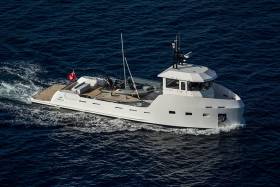Displaying items by tag: wave runners
YXT 20m Support Vessel World Debut At Monaco Yacht Show
The YXT 20 was conceived to support power and sailing yachts of any size, or be an explorer yacht, all on her own.
The large 45 square meter open deck can be a comfortable base for a large tender, a sailboat, 2 wave runners, a big RIB, paddle boards, wind surf boards, Sea Bobs, scuba diving gear, submarines, containers, cars or motorcycles and literally tons of storage.
The YXT 20's interiors design is by Franck Darnet of Franck Darnet Design. The yacht was conceived as a support vessel for superyachts ranging from 30 to over 70 meters. The unit is propelled by two 715hp Cummins diesels giving her a range of 900 nautical miles and a 14 knot cruising speed.
YXT 20 support vessel has a white livery, giving her a fresher and more marine aspect. This color scheme also emphasizes the gamma's production philosophy: created for carrying extra toys and gadgets, the vessel's use is closer to the fun and leisure aspects of seagoing (beach club or party deck, even extra accommodation).
A stern mounted gangway davit, allowing use of the transom beach area to carry tenders and jet skis. The stairs and the first four meters of deck are completed in teak, underlining the yachting style of the YXT 20.
LAYOUT
The YXT 20’s design recognizes that different owners have different objectives, so is available in two versions – “High Profile” with extra freeboard and “Low Profile”.
In the High Profile version, the YXT 20 can accommodate eight with four guest in two luxurious guest cabins. In both versions, four crew enjoy comfortable and efficient crew quarters in two twin cabins with galley, stowage and laundry plus one large storage container accessible from
the main deck. It can also be used for extra refrigerator appliances, wine cellars, or when necessary, even an extra accommodation, a spa or a gym. Like any LYNX yacht, owners can customize and make it their own.
DAVITS AND SUPPORT EQUIPMENT
This is the primary characteristic of every support vessel. The YXT 20 features two davits - the primary is located on the main deck, the secondary, which also serves as the gangway, at the stern. The two 360-degree davits have a lifting capacity of 1.7 tons primary, 0.5 at the stern with a 5 meter reach and 360° slewing.
INTERIORS
Guest area and lounge: bulkheads and overheads in natural wood veneer marine grade plywood, parquet flooring. Furnishings in natural wood veneer marine grade plywood.
CREW QUARTERS
Bulkheads in natural wood veneer marine grade plywood, parquet flooring. Furnishings in white laminate veneer marine grade plywood with wood trim.
YXT 20 STORAGE DIMENSIONS AND VOLUME
Hold: 5m x 5m, 25m2
Available volume: apx. 30m3 of stowage with standing headroom Length: 5m
Width at deck level: apx. 5.5m
Centerline headroom: 1.8m/1.95m
Lateral headroom (for storage only): 1.25m
Available storage volume: 30cbm























